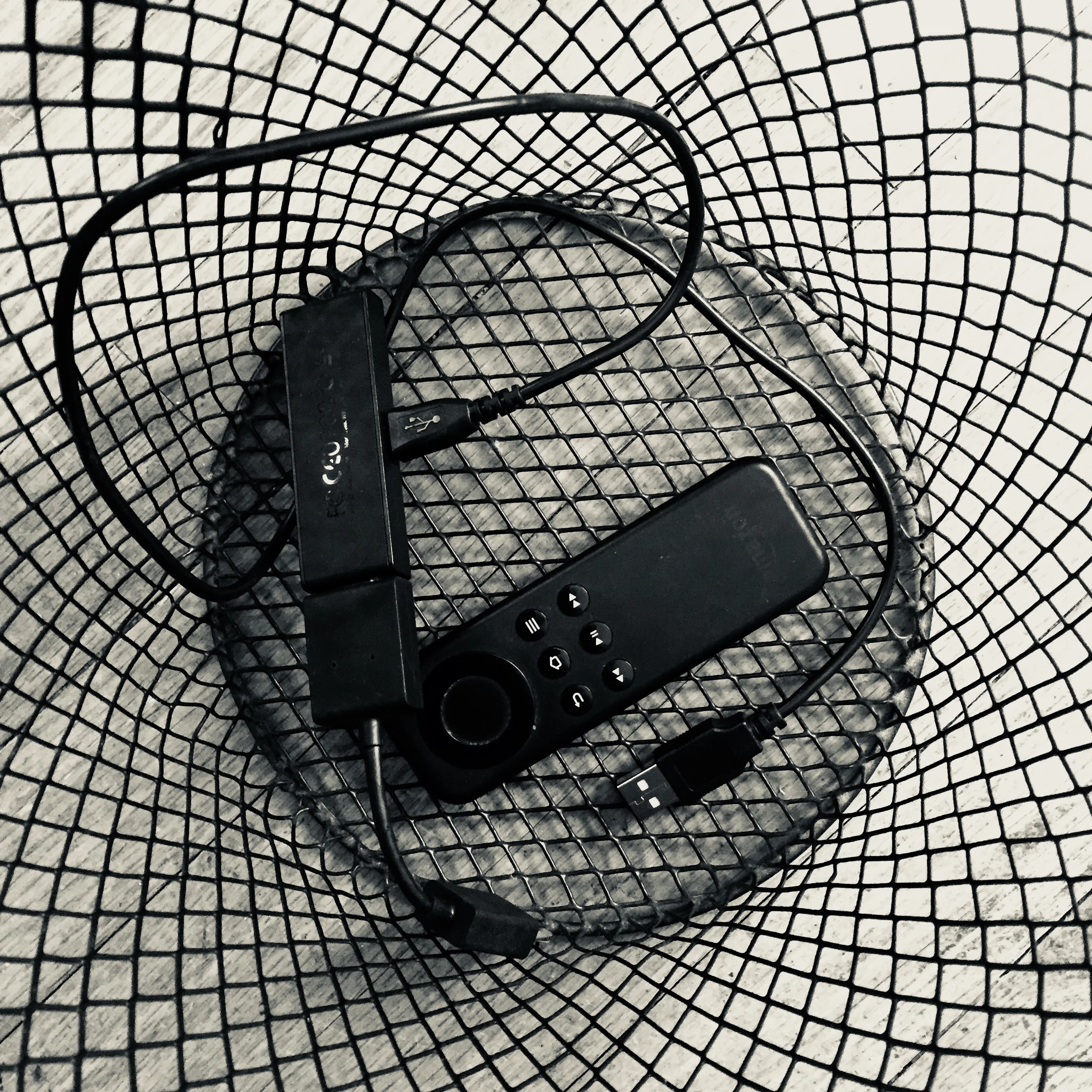Using the New Kindle Fire TV Stick: A Mixed Review
Published Nov. 24, 2014
Out With the Old
With the kitchen TV’s venerable old RokuXDS approaching end-of-life I jumped on the chance to get the new Kindle Fire TV Stick for $19 from Amazon Prime. I frequently watch video podcasts or YouTube videos while cooking or working in the kitchen. The crankiness of the old Roku, plus its lack of access to newer Rokuapps, had me looking for a replacement.
Setup
Setting up the Fire Stick was straightforward. You plug it into an HDMI port on the TV, put the batteries in the remote, connect the power via the USB cable, and select the device via the TVs “source” control.
It immediately picked up the wireless signal from the upstairs re-transmitter. After the usual awkward password entry process via the diminutive remote you’re up and running (or rather, downloading updated software).
If you’re already in Amazon Prime member the device is automatically “registered” with Amazon so when you check your online account status your device is automatically listed. That’s a nice touch as it means you can avoid more use of the dreaded online keyboard to enter account and password information.
Performance
Performance of the device and its user interfaces is snappy. It definitely has the old Roku beat both in speed of making wireless connections and in user interface performance. It is, after all, a much newer device so that shouldn’t be at all surprising.
User Interface
The user interface displays objects in rows and columns. Emphasis is based on slight magnification of the selected object. After using it for a few days and comparing it to the Apple TV connected to the big TV in the living room I decided it’s serviceable but still a bit rough around the edges.
Our Apple TV follows a rigid rectangular layout of selectable objects that can be rapidly scrolled then selected at which point options appear. Amazon has elected to make options available visually and uses highlighting and selected magnification to enable the user to self-locate and navigate. My sense is — and I’m no user interface expert — that there is often much more info and variety on the screen then use the user actually needs at any given point in time. The result is a somewhat cluttered user interface that’s confusing on smaller screens or when seen from across the room.
The Apps
You have to download and install apps to get them to work. Netflix is one example. The process is simple but it’s another set of codes to enter via your computer or tablet; that seems inevitable these days.
Will the app ecosystem extend l beyond the usual suspects? Amazon’s app market has always been smaller than Apple’s and Google’s but your reaction will really be based on what you are looking for. There is an initial set of game apps but I’m not a gamer so that’s not really relevant to me as I expect to be using the Fire Stick for movies, music, and YouTube.
Music
Music wise I don’t buy many files or CDs anymore. iTunes radio is often on when I am working on one of my Windows machines plus I’ve already uploaded several thousand CD tracks to iCloud/iMatch. A few of the CDs I bought from Amazon over the years did show up automatically on the Fire Stick music playlist but my real interest is Prime Music from Amazon. This provides access to a changing population of selected tracks and albums organized by genre (for example, “electronic music to code by”).
Music Playlist Management
Unfortunately to select your prime music playlist you have to go online via computer to the Amazon site and your account configuration page. Once you selected the Prime Music playlist that interest you they then show up on the Fire Stick music menu and are easily selected and played. (You can also add selected individual albums to your playlist.)
Prime vs. Not Prime
My biggest beef with Amazon prime video is not with the selection but with the difficulty of completely screening out nonprime movies and TV programs which inevitably show up as you navigate. I assume this is intentional on Amazon’s part but it continues to be annoying on all the platforms I use for Amazon video (Panasonic plasma TV, iPhone, iPad Mini, Kindle Fire, Windows 8 computers). All I want to do when I select video on the Fire Stick is to indicate — once — “show me only items available the Amazon prime” and be done with it. Currently that doesn’t seem possible even when you think you’re looking at a Prime video list. Perhaps there’s a way to figure out how to make Prime-only filtering permanent but I have not figured it out yet.
Pictures
I’ve experimented with uploading pictures to Prime’s available cloud storage and that process is pretty straightforward. You can also automatically upload new photos from, say, your iPhone but I’m not too sure I want to do that as my picture storage situation is already spread across iCloud, Flickr, Microsoft OneDrive, Google+, and my local machines. Adding another picture site and then managing access and updates is not in the cards for me.
Screensaver Annoyance
So far no matter how many times I set a specific uploaded picture collection as my default Fire Stick screensaver, the setting does not “take” and I have to reset it again. I’m assuming this will be fixed in future releases of the software.
Summary of Reservations
I’ve enjoyed using the Fire Stick and appreciate its snappy performance especially when compared with the older Roku device I’m replacing. The fact that I was able to purchase this device for only $19 (as opposed to $40) is also an added bonus. Still, I do have some issues with the device that I think should be considered when looking for a media device like this.
The user interface itself is a bit confusing with its mix of row and column organization, highlighting, and magnification. It’s easy to lose track of where you are. I can also imagine that someone who is colorblind might have extra problems since color is used to indicate a selection at some points. Again, I go back to the Apple TV; the rigidity of that machine’s user interface and how options are invisible till needed or selected suggests me that, for new users especially, the Apple TV interface will be easier to navigate.
Recommendations? It depends.
Also keep in mind that I consider myself to be a fairly experienced user and constantly jump from device to device. Adjusting from one interface to another is a normal occurrence for me. While I am adjusting to the Amazon Fire Stick’s user interface for my personal use I have to say I am going to be very careful about recommending it to others depending upon their experience and their investment in the Apple and Amazon ecosystems, as well as their newness to streaming services such as Netflix or Amazon Prime as alternatives to regular TV. The Fire Stick is a bit of a challenge. Its minor annoyances such as forgetting the screen saver settings and having to go back to the Amazon website to configure music playlists tend to add up for me but by themselves they probably shouldn’t be viewed as deal breakers.
No Kindle and No Audible
I was disappointed that my Kindle and Audible books don’t show up. That would have been nice, to display or listen to the books I purchased from Amazon; Audible would be nice as I could listen to books while working in the kitchen. Maybe apps for Kindle and Audible will occur in the future for the Fire Stick; meanwhile, I’ll use the very nicely performing iOSapps (and my old Kindle Fire).
Rating
Overall I’d give the Fire Stick a C+ or B- in functionality. It’s certainly faster than the old Roku and gives me much better access to my Amazon ecosystem despite the absence of Kindle books and Audible.
Certainly for the price I can’t fall it. At $19 it was a steal. Even at $40 it’s still a great deal.
What’s Really Going On
Still, I have some significant misgivings. The awkwardness of the user interface is s probably the main reason I’m reluctant to recommend it to a novice.
I think that Amazon is facing a major challenge in developing a media consumption device like the Fire Stick because so far Amazon has not figured out how to effectively insulate the Fire Stick user from the rest of the Amazon ecosystem. To do certain things including account maintenance you have to go to the vastly complex Amazon website. To manager the Prime Music playlists, for example, you have to first find the right page and, once you’re there, you then have to understand and perform the selection process. Only then can you go back to your Fire Stick and play the music you just selected.
To be fair, the Amazon.com website was a bitch to navigate long before the arrival of the Fire Stick. Still, I think Amazon is playing a bit of catch-up with Apple which is not hobbled as much by the need to use the same web site and account maintenance services to sell coffee, lawnmowers, and shoes.
Conclusion
I’m not saying that Apple is “better” than Amazon overall but I do think that Apple with its narrower product focus has had a lot more experience with creating a simpler and more intuitive user interface than Amazon and this might be one of the reasons the Fire Stick user experience seems a bit rough around the edges to me.
Now, if only I could get Amazon Prime on Apple TV!
Copyright (c) 2014 by Dennis D. McDonald. Can I help you adapt the content and ideas you see here for your own organization? Contact me at ddmcd@outlook.com.




